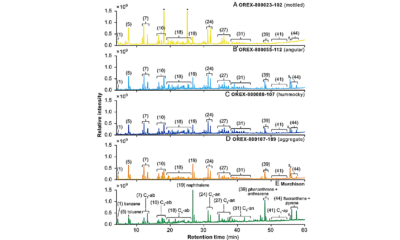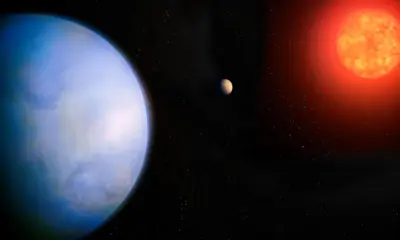Science
Black Hole Mergers Redefine Understanding of Cosmic Evolution

Recent advancements in gravitational wave astronomy have led to significant discoveries regarding black hole mergers. During October and November 2024, the LIGO-Virgo-KAGRA collaboration detected two extraordinary black hole mergers that challenge existing theories about their formation and evolution. Both events showcased rapidly spinning black holes in unequal mass pairs, suggesting a history of violent interactions rather than a quiet stellar origin.
The first event, designated GW241011, occurred approximately 700 million light years from Earth. It involved two black holes with masses of 20 and 6 solar masses spiraling together. This merger is notable for the exceptionally rapid spin of the larger black hole, marking it as one of the fastest rotating black holes ever identified through gravitational waves.
Just a month later, the second merger, GW241110, was detected at a greater distance of 2.4 billion light years. This event featured black holes of 17 and 8 solar masses. A remarkable aspect of this merger was the primary black hole spinning in the opposite direction to its orbit, a configuration that had never been directly observed before.
Revising Theories on Black Hole Origins
These findings significantly impact our understanding of black hole origins. Typically, when massive stars collapse, they leave behind black holes with modest spins aligned with their original motion. The dramatic spins observed in both GW241011 and GW241110 suggest that these black holes are not first-generation forms created directly from stellar collapse. Instead, they are likely the result of earlier mergers, referred to as second-generation black holes.
This hypothesis is supported by the fact that in both cases, the larger black hole was nearly double the mass of its companion. Such mass disparity is more consistent with hierarchical mergers rather than binary stars that formed together. This pattern implies that these systems likely formed in dense stellar environments, such as globular clusters, where black holes frequently collide and merge over time. Each collision adds mass and can dramatically alter spin, contributing to the unusual properties observed.
The clarity of the signal from GW241011 also allowed astronomers to verify Albert Einstein’s theory of general relativity with remarkable precision. The rapid rotation of the primary black hole results in a slight deformation of the object, a phenomenon predicted by mathematician Roy Kerr‘s solution for rotating black holes. The gravitational waves carry this deformation as a distinctive signature that aligns closely with theoretical predictions. Additionally, the signal included higher harmonics, akin to overtones in musical instruments, further confirming Einstein’s theories.
The Future of Gravitational Wave Astronomy
As detector sensitivity continues to improve, astronomers anticipate more discoveries akin to GW241011 and GW241110. These findings will likely reveal a broader range of environments where black holes collide, helping to refine our understanding of the fundamental laws governing these extreme cosmic objects. The ongoing research in this field promises to unravel more mysteries about the universe and the complex interactions that shape its evolution.
The implications of these discoveries extend beyond theoretical physics, reshaping our understanding of cosmic history and the life cycles of stars. As gravitational wave astronomy advances, it opens a new frontier for exploring the universe, one merger at a time.
-

 Technology5 months ago
Technology5 months agoDiscover the Top 10 Calorie Counting Apps of 2025
-

 Health2 months ago
Health2 months agoBella Hadid Shares Health Update After Treatment for Lyme Disease
-

 Health3 months ago
Health3 months agoErin Bates Shares Recovery Update Following Sepsis Complications
-

 Technology4 months ago
Technology4 months agoDiscover How to Reverse Image Search Using ChatGPT Effortlessly
-

 Technology1 month ago
Technology1 month agoDiscover 2025’s Top GPUs for Exceptional 4K Gaming Performance
-

 Technology2 months ago
Technology2 months agoElectric Moto Influencer Surronster Arrested in Tijuana
-

 Technology5 months ago
Technology5 months agoMeta Initiates $60B AI Data Center Expansion, Starting in Ohio
-

 Technology5 months ago
Technology5 months agoRecovering a Suspended TikTok Account: A Step-by-Step Guide
-

 Health4 months ago
Health4 months agoTested: Rab Firewall Mountain Jacket Survives Harsh Conditions
-

 Lifestyle5 months ago
Lifestyle5 months agoBelton Family Reunites After Daughter Survives Hill Country Floods
-

 Technology4 months ago
Technology4 months agoHarmonic Launches AI Chatbot App to Transform Mathematical Reasoning
-

 Technology3 months ago
Technology3 months agoUncovering the Top Five Most Challenging Motorcycles to Ride




















